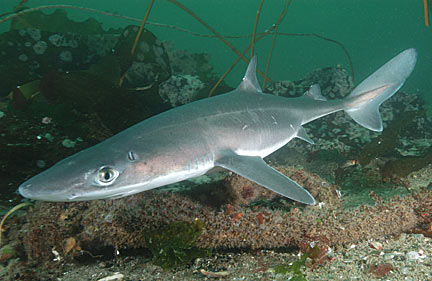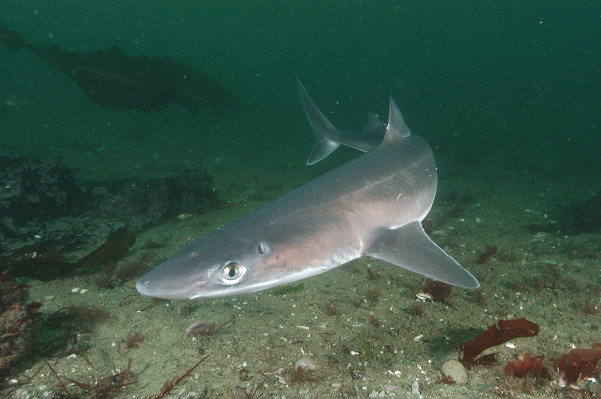
Spiny Dogfish

Spiny Dogfish

Spiny Dogfish

Facts
| Also known as: | piked dogfish, common spinyfish and white-spotted spurdog |
|---|
| Kingdom | Animalia |
|---|---|
| Phylum | Chordata |
| Class | Chondrichthyes |
| Order | Squaliformes |
| Family | Squalidae |
| Genus | Squalus (1) |
| Size | Male length: up to 100 cm (2) Female length: up to 124 cm (2) |
Status
Classified as Vulnerable (VU) on the IUCN Red List.
Description
The common name ‘dogfish' was given by fisherman to small sharks due to their habit of hunting shoals of fish in ‘packs' (3). The spiny dogfish is a small, slim fish with a narrow, pointed snout and distinctive white spots (4). The back is slate grey to brown and the belly is pale grey to white. It has two dorsal fins, the first of which is smaller (3). They both have a spine which can inject venom causing strong pain lasting for several hours, and very occasionally death in humans (4). The pectoral fins are curved and have rounded tips (3).
Range
Distributed along coastlines, the spiny dogfish is found in the western Atlantic, eastern Atlantic, western Pacific and eastern Pacific, as well as the Mediterranean Sea and the Black Sea (4).
Habitat
Found from the surface to a depth of 900 metres, the spiny dogfish is thought to tolerate in temperatures of between 7 and 15 degrees Celsius.
Biology
Said to be the most abundant living shark, the spiny dogfish is a slow, inactive swimmer and forms massive feeding aggregations of thousands of individuals. Tending to be same-sex and same-size shoals, they prey on shoals of bony fish, as well as octopuses, smaller sharks, squid, crabs and shark egg cases (3). They are highly migratory, moving towards the equatorial side of their range during winter (2).
With estimates of between 20 years and 75 years, the spiny dogfish is thought to be a very long-lived fish that matures late and reproduces slowly, with gestation lasting two years – the longest of any vertebrate (1) (2) (3). An ovoviviparous species, spiny dogfish develop in eggs within the female, and gain nourishment from their yolk sacs, After four to six months, these eggs are shed, but the embryos continue to develop inside the female, still living off the yolk sac attached to their abdomens. Finally, after another 18 to 20 months of development, six to seven live young are born, measuring 20 to 33 centimetres.
Despite possessing venom-delivering spines on each of its two dorsal fins, the spiny dogfish is eaten by cod, red hake, goosefish, other spiny dogfish, larger sharks, seals, and orcas (2).
Threats
The spiny dogfish is considered to be the most abundant living shark, yet two particular subpopulations in the northwest and northeast Atlantic Ocean are considered to be at risk due to massive fishing pressure. This shark is caught for food, liver oil, and used to make sand paper, vitamins, leather, fertiliser, pet food and fish meal (1) (4). At a time of peak abundance between 1900 and 1910, it is estimated that up to 27 million spiny dogfish were caught off the Massachusetts coast every year (5).

No comments:
Post a Comment